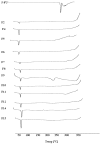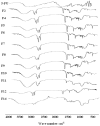Optimization of 5-flurouracil solid-lipid nanoparticles: a preliminary study to treat colon cancer
- PMID: 21103076
- PMCID: PMC2990076
- DOI: 10.7150/ijms.7.398
Optimization of 5-flurouracil solid-lipid nanoparticles: a preliminary study to treat colon cancer
Abstract
Solid lipid nanoparticle (SLNs) formulae were utilized for the release of 5-flurouracil (5-FU) inside the colonic medium for local treatment of colon cancer. SLNs were prepared by double emulsion-solvent evaporation technique (w/o/w) using triglyceride esters, Dynasan™ 114 or Dynasan™ 118 along with soyalecithin as the lipid parts. Different formulation parameters; including type of Dynasan, soyalicithin:Dynasan ratio, drug:total lipid ratio, and polyvinyl alcohol (PVA) concentration were studied with respect to particle size and drug entrapment efficiency. Results showed that formula 8 (F8) with composition of 20% 5-FU, 27% Dynasan™ 114, and 53% soyalithicin andformula 14 (20% 5-FU, 27% Dynasan™ 118, and 53% soyalithicin), which were stabilized by 0.5% PVA, as well as F10 with similar composition as F8 but stabilized by 2% PVA were considered the optimum formulae as they combined small particle size and relatively high encapsulation efficiencies. F8 had a particle size of 402.5 nm ± 34.5 with a polydispersity value of 0.005 and an encapsulation efficiency of 51%, F10 had a 617.3 ± 54.3 nm particle size with 0.005 polydispersity value and 49.1% encapsulation efficiency, whereas formula F14 showed a particle size of 343 nm ± 29 with 0.005 polydispersity, and an encapsulation efficiency of 59.09%. DSC and FTIR results suggested the existence of the lipids in the solid crystalline state. Incomplete biphasic prolonged release profile of the drug from both formulae was observed in phosphate buffer pH 6.8 as well as simulated colonic medium containing rat caecal contents. A burst release with magnitudes of 26% and 28.8% cumulative drug released were noticed in the first hour samples incubated in phosphate buffer pH 6.8 for both F8 and F14, respectively, followed by a slow release profile reaching 50% and 52% after 48 hours.
Keywords: 5-flurouraci; Dynasan; Solid lipid nanoparticles; colon cancer; double emulsion; polyvinyl alcohol.
Conflict of interest statement
Conflict of Interest: The authors have declared that no conflict of interest exists.
Figures





Similar articles
-
Solid lipid nanoparticles for thermoresponsive targeting: evidence from spectrophotometry, electrochemical, and cytotoxicity studies.Int J Nanomedicine. 2017 Nov 21;12:8325-8336. doi: 10.2147/IJN.S147506. eCollection 2017. Int J Nanomedicine. 2017. PMID: 29200845 Free PMC article.
-
Characterization and evaluation of 5-fluorouracil-loaded solid lipid nanoparticles prepared via a temperature-modulated solidification technique.AAPS PharmSciTech. 2014 Dec;15(6):1498-508. doi: 10.1208/s12249-014-0168-x. Epub 2014 Jul 18. AAPS PharmSciTech. 2014. PMID: 25035070 Free PMC article.
-
Enhanced oral bioavailability of insulin-loaded solid lipid nanoparticles: pharmacokinetic bioavailability of insulin-loaded solid lipid nanoparticles in diabetic rats.Drug Deliv. 2016 Jul;23(6):1972-9. doi: 10.3109/10717544.2015.1039666. Epub 2015 May 27. Drug Deliv. 2016. PMID: 26017100
-
Nanoparticles as tool for enhanced ophthalmic delivery of vancomycin: a multidistrict-based microbiological study, solid lipid nanoparticles formulation and evaluation.Drug Dev Ind Pharm. 2016 Nov;42(11):1752-62. doi: 10.3109/03639045.2016.1171335. Epub 2016 Apr 19. Drug Dev Ind Pharm. 2016. PMID: 27093938
-
Harnessing unique architecture and emerging strategies of solid lipid nanoparticles to combat colon cancer: A state-of-the-art review.Int J Pharm. 2025 Apr 30;675:125562. doi: 10.1016/j.ijpharm.2025.125562. Epub 2025 Apr 5. Int J Pharm. 2025. PMID: 40194729 Review.
Cited by
-
Advances in orally targeted drug delivery to colon.J Adv Pharm Technol Res. 2019 Jul-Sep;10(3):100-106. doi: 10.4103/japtr.JAPTR_26_19. J Adv Pharm Technol Res. 2019. PMID: 31334090 Free PMC article. Review.
-
Preparation, Evaluation and Bioavailability Studies of Eudragit Coated PLGA Nanoparticles for Sustained Release of Eluxadoline for the Treatment of Irritable Bowel Syndrome.Front Pharmacol. 2017 Nov 20;8:844. doi: 10.3389/fphar.2017.00844. eCollection 2017. Front Pharmacol. 2017. PMID: 29209215 Free PMC article.
-
Brain-targeted delivery of Valsartan using solid lipid nanoparticles labeled with Rhodamine B; a promising technique for mitigating the negative effects of stroke.Drug Deliv. 2023 Dec;30(1):2179127. doi: 10.1080/10717544.2023.2179127. Drug Deliv. 2023. PMID: 36794404 Free PMC article.
-
Development of Sustained Release Baricitinib Loaded Lipid-Polymer Hybrid Nanoparticles with Improved Oral Bioavailability.Molecules. 2021 Dec 28;27(1):168. doi: 10.3390/molecules27010168. Molecules. 2021. PMID: 35011397 Free PMC article.
-
Preparation and Evaluation of Carbamazepine Solid Lipid Nanoparticle for Alleviating Seizure Activity in Pentylenetetrazole-Kindled Mice.Molecules. 2019 Nov 2;24(21):3971. doi: 10.3390/molecules24213971. Molecules. 2019. PMID: 31684021 Free PMC article.
References
-
- Viñas-Salas J, Biendicho-Palau P, Piñol-Felis C. et al.Calcium inhibits colon carcinogenesis in an experimental model in the rat. Eur J Cancer. 1998;34:1941–1945. - PubMed
-
- Davis LE, Krawczeniuk MM. Colorectal Cancer. In: Dipiro JT, editor. Pharmacotherapy a Pathophysiologica Approach. New Jersey, USA: Prentice Hall; 1997. pp. 2513–2538.
-
- Shoo SK, Parveen S, Panda JJ. The present and future of nanotechnology in human health care. Nanotechnology. 2007;3:20–31. - PubMed
-
- Park JH, Lee S, Kim JH. et al.Polymeric nanomedicine for cancer therapy. Prog Polym Sci. 2008;33:113–137.
Publication types
MeSH terms
Substances
LinkOut - more resources
Full Text Sources
Other Literature Sources
Miscellaneous

